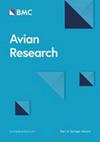Decreased basal thermogenesis is associated with the downregulation of cellular metabolic activity of organs and serum thyroid hormones in fasting Eurasian Tree Sparrows (Passer montanus)
IF 1.6
2区 生物学
Q1 ORNITHOLOGY
引用次数: 0
Abstract
Food is a critical environmental factor that influences animal survival, especially for small passerines due to their high mass-specific metabolic rates. Basal metabolic rate (BMR) reflects the energy expended by endothermic animals for basic physiological processes and constitutes a major part of their daily energy budget. Some birds have been shown to employ compensatory mechanisms during food shortages, temporarily reducing these self-maintenance expenditures without using hypothermia. However, the mechanisms of BMR adjustment remain unexplored. In the present study, we assessed the phenotypic variation in basal thermogenesis of Eurasian Tree Sparrows (Passer montanus) by comparing a control group to groups fasted for 6, 12, 18, and 24 h. We focused on the correlation between a reduction in energy metabolism and the alterations of cellular metabolic activities, mitochondrial substrate supply, and changes in serum thyroid hormones during fasting. Our data indicated that fasting groups had significantly lower body mass, BMR, body temperature, and body fat content. Furthermore, fasting groups had significantly lower glycogen levels, mitochondrial state 4 respiration and cytochrome c oxidase (CCO) activity in the liver, and CCO activity in pectoral muscle. The levels of avian uncoupling protein (av-UCP) mRNA were significantly reduced, while the levels of myostatin protein in pectoral muscle were significantly increased in the fasting groups. Furthermore, the groups subjected to fasting exhibited significantly lower levels of serum glucose, triglyceride, thyroxine (T4), and triiodothyronine (T3). Positive correlations were observed between the following pairs of variables: log BMR and log body mass, log body mass and log body fat, log BMR and log state 4 respiration in the liver, log BMR and log CCO activity in the liver and muscle, log BMR and log av-UCP mRNA expression, whereas a negative correlation was observed between log BMR and log myostatin level. In addition, a positive correlation was also detected between log T3 and each of the following: log BMR, state 4 respiration, and log CCO activity in the liver. Our results suggested that decreased metabolic thermogenesis via down-regulation in cellular aerobic capacity of organs and serum thyroid hormones may be an important survival strategy for fasting Tree Sparrows to reduce energy expenditure.
空腹欧亚树雀(Passer montanus)体内器官细胞代谢活性和血清甲状腺激素下调与基础产热能力下降有关
食物是影响动物生存的关键环境因素,尤其是小型雀形目动物,因为它们具有较高的质量代谢率。基础代谢率(BMR)反映了吸热动物在基本生理过程中消耗的能量,是其日常能量收支的重要组成部分。一些鸟类在食物短缺时采用补偿机制,在不使用低温的情况下暂时减少这些自我维持的支出。然而,BMR调节的机制仍未被探索。在本研究中,我们通过将对照组与禁食6、12、18和24小时的组进行比较,评估了欧亚树雀(Passer montanus)基础产热的表型变化。我们重点研究了能量代谢减少与禁食期间细胞代谢活动、线粒体底物供应和血清甲状腺激素变化之间的相关性。我们的数据表明,禁食组的体重、BMR、体温和体脂含量明显较低。此外,空腹组糖原水平、线粒体状态4呼吸和肝脏细胞色素c氧化酶(CCO)活性以及胸肌CCO活性均显著降低。空腹组胸肌中禽解偶联蛋白(av-UCP) mRNA水平显著降低,肌生长抑制素蛋白水平显著升高。此外,禁食组的血清葡萄糖、甘油三酯、甲状腺素(T4)和三碘甲状腺原氨酸(T3)水平显著降低。对数BMR与对数体重、对数体重与对数体脂、对数BMR与肝脏呼吸、对数BMR与肝脏和肌肉的对数CCO活性、对数BMR与对数v- ucp mRNA表达呈正相关,而对数BMR与对数肌肉生成抑制素水平呈负相关。此外,还检测到log T3与以下各项之间的正相关:log BMR,状态4呼吸和肝脏中log CCO活性。我们的研究结果表明,通过下调器官细胞有氧能力和血清甲状腺激素来减少代谢性产热可能是禁食树麻雀减少能量消耗的重要生存策略。
本文章由计算机程序翻译,如有差异,请以英文原文为准。
求助全文
约1分钟内获得全文
求助全文
来源期刊

Avian Research
ORNITHOLOGY-
CiteScore
2.90
自引率
16.70%
发文量
456
审稿时长
46 days
期刊介绍:
Avian Research is an open access, peer-reviewed journal publishing high quality research and review articles on all aspects of ornithology from all over the world. It aims to report the latest and most significant progress in ornithology and to encourage exchange of ideas among international ornithologists. As an open access journal, Avian Research provides a unique opportunity to publish high quality contents that will be internationally accessible to any reader at no cost.
 求助内容:
求助内容: 应助结果提醒方式:
应助结果提醒方式:


